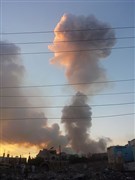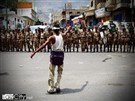To begin to understand the trajectory of recent political developments in Yemen, it is necessary to cast one’s eye back further than the heady days of 2011. Undoubtedly, events in Egypt and Tunisia have lent considerable force to demonstrations in the capital, Sana’a. However, it would be unfair to the thousands of Yemenis who for years have organized daily protests throughout the country and the thousands who have been killed, imprisoned, injured and tortured by the state to say that the widespread popular organizing against the regime of `Ali `Abdullah Salih had its genesis anywhere but Yemen.
There have been street protests throughout Yemen, and especially in the south, since 2007. While the southern protesters are now demanding secession, their initial demands included grievances similar to those articulated in Egypt and Tunisia, including complaints of unemployment, increasing economic destitution, as well as political repression and underrepresentation. It was unsurprising that the grievances articulated by the southern protesters became anti-northern and secessionist in nature. A majority of Yemen’s resources flow from oil fields, fisheries, and ports in the south into the coffers of the national government that largely favors infrastructure projects and government patrons based in Sana’a. Eager to isolate southern grievances from similar rumblings in the north, the government framed the southern protests as a regional nationalistic agitation held over from 1994, when the former north and south Yemen states fought a post-unification civil war. The government’s efforts were successful as southern grievances slowly evolved into calls for secession and popular northern reaction was anger and defensiveness against the southerners who came to be perceived as people who sought to destroy national unity and who “have wanted to secede since 1990.”
While there have been sporadic protests throughout the north (and a rebellion north of Sana’a that has been ongoing for almost a decade), it was the protests in Tunisia and then Egypt that triggered the larger and more persistent protests in Sana’a and Taiz (the second largest city in the north), which have been primarily organized by university students and other middle class activists. The protests in Sana’a overtly seek to learn from and replicate the protests in Egypt, including calling themselves “the youth movement”, the use of slogans (“the people want the fall of the regime,”), the emphasis on peaceful protests, setting up a public projector screen to broadcast Al-Jazeera (in Taiz) and the use of Twitter, Facebook, Youtube and other sites to publicize protester actions and government responses.
This article is now featured in Jadaliyya`s edited volume entitled Dawn of the Arab Uprisings: End of An Old Order? (Pluto Press, 2012). The volume documents the first six months of the Arab uprisings, explaining the backgrounds and trajectories of these popular movements. It also archives the range of responses that emanated from activists, scholars, and analysts as they sought to make sense of the rapidly unfolding events. Click here to access the full article by ordering your copy of Dawn of the Arab Uprisings from Amazon, or use the link below to purchase from the publisher.

![[Poster of Ali Abdullah Saleh. Arabic text reads \"leave\" and \"wanted for justice.\" Image from facebook.com/taiz.city]](https://kms.jadaliyya.com/Images/357x383xo/yemenprotests.jpg)










